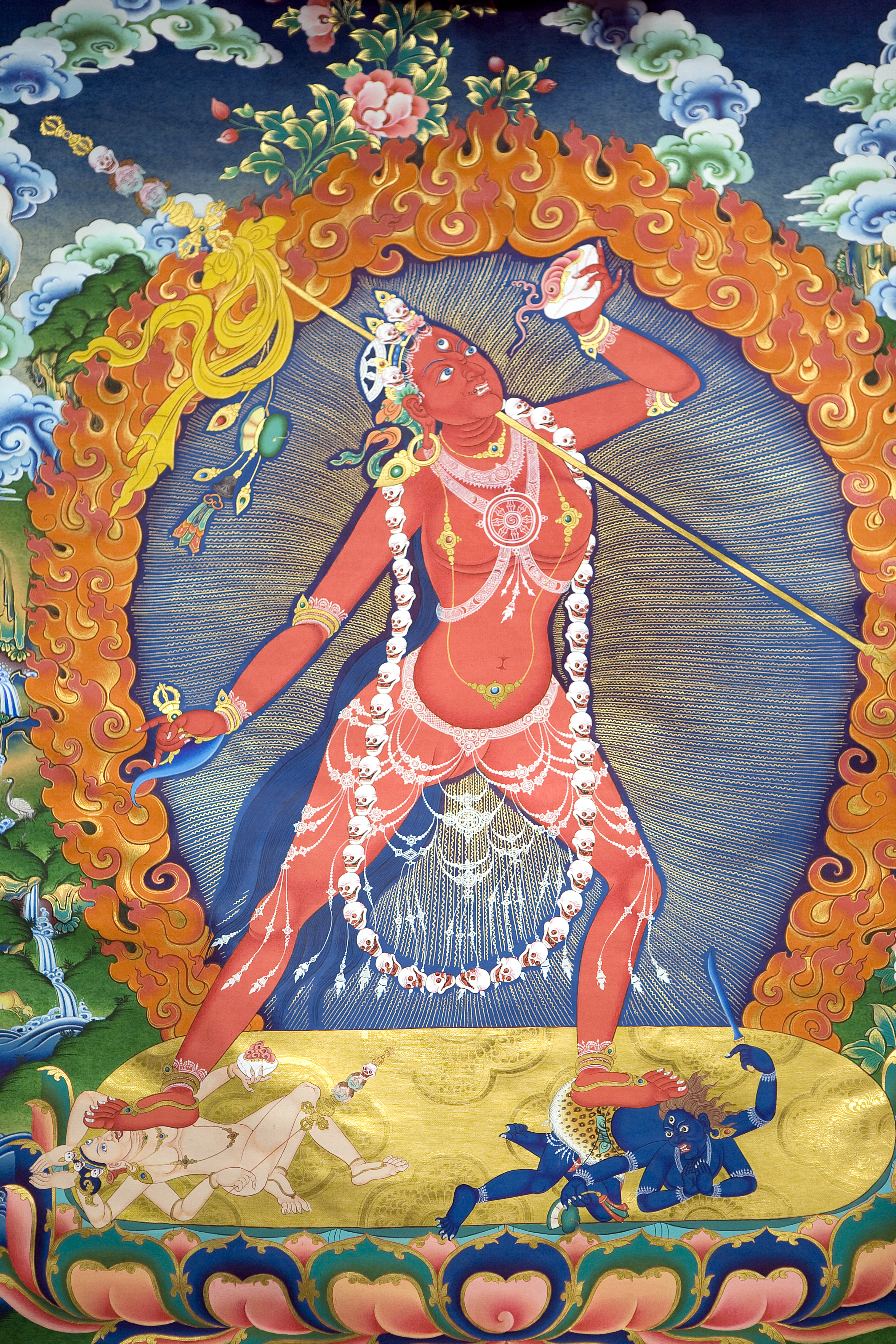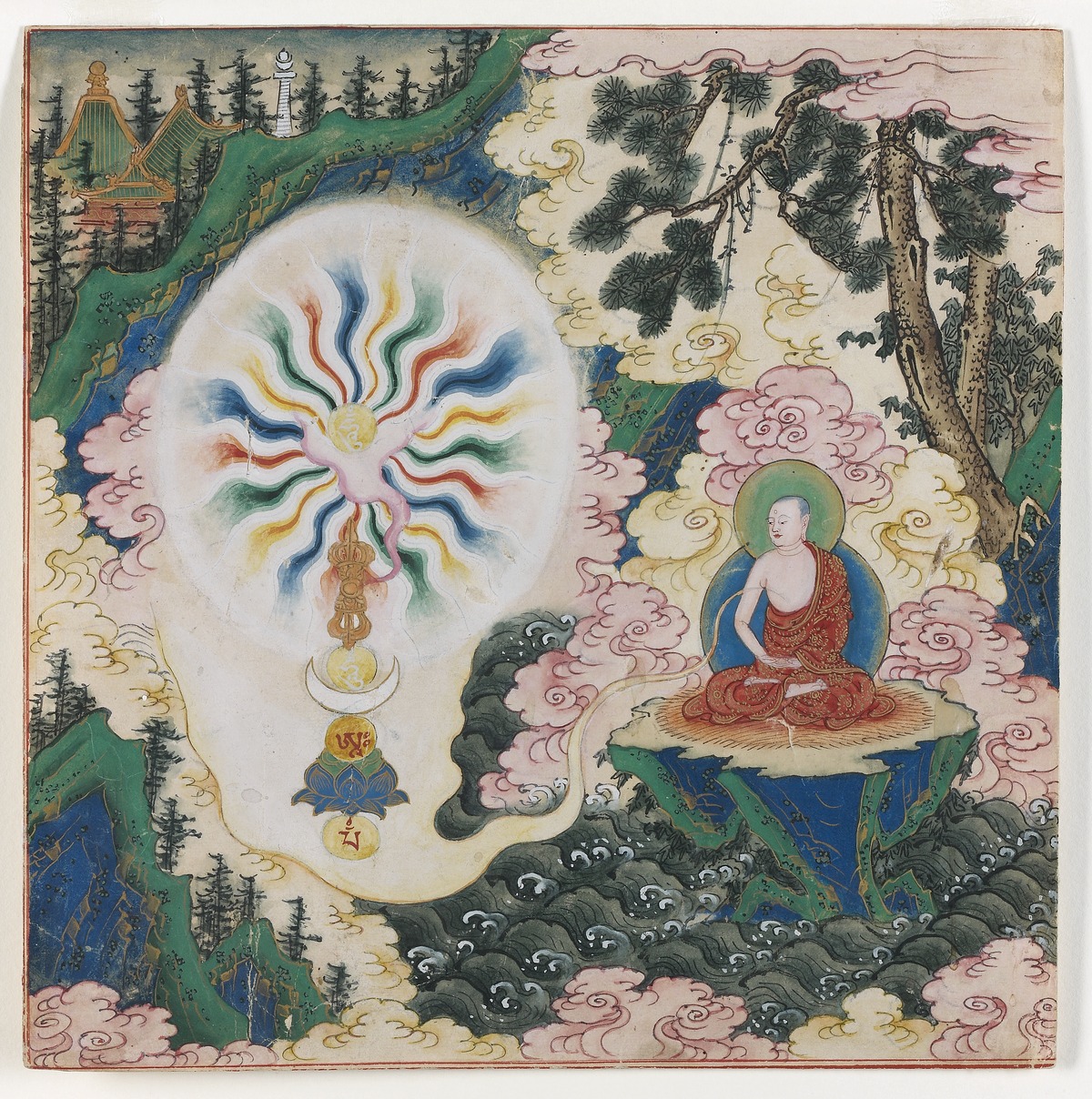|
Wrathful Deities
In Buddhism, wrathful deities or fierce deities are the fierce, wrathful or forceful (Tibetan: ''trowo'', Sanskrit: ''krodha'') forms (or "aspects", "manifestations") of enlightened Buddhas, Bodhisattvas or Devas (divine beings); normally the same figure has other, peaceful, aspects as well. Because of their power to destroy the obstacles to enlightenment, they are also termed ''krodha-vighnantaka'', "Wrathful onlookers on destroying obstacles". Wrathful deities are a notable feature of the iconography of Mahayana and Vajrayana Buddhism, especially in Tibetan art. These types of deities first appeared in India during the late 6th century, with its main source being the Yaksha imagery, and became a central feature of Indian Tantric Buddhism by the late 10th or early 11th century. Overview In non-Tantric traditions of Mahayana Buddhism, these beings are protector deities who destroy obstacles to the Buddhas and the Dharma, act as guardians against demons and gather together sentien ... [...More Info...] [...Related Items...] OR: [Wikipedia] [Google] [Baidu] |
Robert Buswell Jr
Robert Evans Buswell Jr. is an American academic, author and scholar of Korean Buddhism and Chinese Buddhism as well as Korean religions in general. He is Distinguished Professor of Buddhist Studies at the University of California, Los Angeles and founding director of the Academy of Buddhist Studies (불교 학술원) at Dongguk University, Korea's main Buddhist university. Education Buswell began his undergraduate education at the University of California, Santa Barbara and attended between September, 1971 and December, 1972. His focus was Asian Studies. Buswell then left the United States and became a Buddhist monk in Thailand, then Taiwan, and finally The Republic of Korea where he spent five years at Songgwangsa. This experience was related in his book ''The Zen Monastic Experience: Buddhist Practice in Contemporary Korea''.Princeton University Press"The Zen Monastic Experience: Buddhist Practice in Contemporary Korea"''Princeton University Press'' (US). retrieved 2014-03-15 ... [...More Info...] [...Related Items...] OR: [Wikipedia] [Google] [Baidu] |
Vajrayogini
Vajrayoginī ( sa, italic=yes, Vajrayoginī वज्रयोगिनी; , Dorjé Neljorma; mn, Огторгуйд Одогч, Нархажид, ) is a Tantric Buddhist female Buddha and a . The ''Vajrayogini'' cult dates back to the tenth and twelfth centuries. Vajrayoginī's essence is "great passion" (''maharaga''), a transcendent passion that is free of selfishness and illusion—she intensely works for the well-being of others and for the destruction of ego clinging. She is seen as being ideally suited for people with strong passions, providing the way to transform those passions into enlightened virtues. She is an Anuttarayoga Tantra iṣṭadevatā (meditation deity) and her practice includes methods for preventing ordinary death, intermediate state ( bardo) and rebirth ( samsara) by transforming them into paths to enlightenment, and for transforming all mundane daily experiences into higher spiritual paths. Practices associated with her are Chöd and the Six Yogas ... [...More Info...] [...Related Items...] OR: [Wikipedia] [Google] [Baidu] |
Dakini
A ḍākinī ( sa, डाकिनी; ; mn, хандарма; ; alternatively 荼枳尼, ; 荼吉尼, ; or 吒枳尼, ; Japanese: 荼枳尼 / 吒枳尼 / 荼吉尼, ''dakini'') is a type of female spirit, goddess, or demon in Hinduism and Buddhism. The concept of the ḍākinī somewhat differs depending on the context and the tradition. For instance, in earlier Hindu texts and East Asian esoteric Buddhism, the term denotes a race of demonesses who ate the flesh and/or vital essence of humans. In Hindu Tantric literature, Ḍākinī is the name of a goddess often associated with one of the six chakras or the seven fundamental elements (''dhātu'') of the human body. In Nepalese and Tibetan Buddhism, meanwhile, 'ḍākinī' (also wisdom ḍākinī) can refer to both what can be best described as fierce-looking female embodiments of enlightened energy and to human women with a certain amount of spiritual development, both of which can help Tantric initiates attaining enligh ... [...More Info...] [...Related Items...] OR: [Wikipedia] [Google] [Baidu] |
Dakini
A ḍākinī ( sa, डाकिनी; ; mn, хандарма; ; alternatively 荼枳尼, ; 荼吉尼, ; or 吒枳尼, ; Japanese: 荼枳尼 / 吒枳尼 / 荼吉尼, ''dakini'') is a type of female spirit, goddess, or demon in Hinduism and Buddhism. The concept of the ḍākinī somewhat differs depending on the context and the tradition. For instance, in earlier Hindu texts and East Asian esoteric Buddhism, the term denotes a race of demonesses who ate the flesh and/or vital essence of humans. In Hindu Tantric literature, Ḍākinī is the name of a goddess often associated with one of the six chakras or the seven fundamental elements (''dhātu'') of the human body. In Nepalese and Tibetan Buddhism, meanwhile, 'ḍākinī' (also wisdom ḍākinī) can refer to both what can be best described as fierce-looking female embodiments of enlightened energy and to human women with a certain amount of spiritual development, both of which can help Tantric initiates attaining enligh ... [...More Info...] [...Related Items...] OR: [Wikipedia] [Google] [Baidu] |
Kīla (Buddhism)
The ''phurba'' (; alternate transliterations: ''phurpa'', ''phurbu'', ''purbha'', or ''phurpu'') or ''kīla'' (Sanskrit Devanagari: कील; IAST: kīla) is a three-sided peg, stake, knife, or nail-like ritual implement traditionally associated with Indo-Tibetan Buddhism, Bön, and Indian Vedic traditions. The phurba is associated with the practice of the meditational deity (Sanskrit ''ishtadevata'', Tibetan ''yidam'') Vajrakīlaya (Tibetan ''Dorje Phurba'') or Vajrakīla (वज्रकील). Etymology Most of what is known of the Indian ''kīla'' lore has come by way of Tibetan culture. Scholars such as F. A. Bischoff, Charles Hartman and Martin Boord have shown that the Tibetan literature widely asserts that the Sanskrit for their term ''phurba'' is ''kīlaya'' (with or without the long ''i''). However, as Boord describes it, Mayer (1996) contests Boord's assertion, pointing out that eminent Sanskritists such as Sakya Pandita employed ''Vajrakīlaya''. Further, he ... [...More Info...] [...Related Items...] OR: [Wikipedia] [Google] [Baidu] |
Mahākāla
Mahākāla is a deity common to Hinduism and Tantric Buddhism. In Buddhism, Mahākāla is regarded as the sacred ''Dharmapāla'' ("Protector of the Dharma"), while in Hinduism, Mahākāla is a fierce manifestation of the Hindu god Shiva and the consort of the goddess Mahākālī; he most prominently appears in the ''Kalikula'' sect of Shaktism. Mahākāla also appears as a protector deity in Vajrayana, Chinese Esoteric, and Tibetan Buddhism (see Citipati), and also in the Chàn and Shingon traditions. He is known as ''Dàhēitiān'' and '' Daaih'hāktīn'' ( 大黑天) in Mandarin and Cantonese, ''Daeheukcheon'' (대흑천) in Korean, ''Đại Hắc Thiên'' in Vietnamese, and ''Daikokuten'' ( 大黒天) in Japanese. Etymology is a Sanskrit bahuvrihi of ' "great" and ' "time/death", which means "beyond time" or death. means "Great Black One". "Protector" is also used to refer specifically to Mahākāla. Description According to ''Shaktisamgama Tantra'', the spouse ... [...More Info...] [...Related Items...] OR: [Wikipedia] [Google] [Baidu] |
Cakrasaṃvara Tantra
The ''Cakrasaṃvara Tantra'' (, ''khorlo demchok,'' The "Binding of the Wheels" Tantra) is an influential Buddhist Tantra. It is roughly dated to the late eight or early ninth century by David B. Gray (with a ''terminus ante quem'' in the late tenth century). The full title in the Sanskrit manuscript used by Gray's translation is: ''Great King of Yoginī Tantras called the Śrī Cakrasaṃvara'' (''Śrīcakrasaṃvara-nāma-mahayoginī-tantra-rāja''). The text is also called the ''Discourse of Śrī Heruka'' (''Śrīherukābhidhāna'') and the ''Samvara Light'' (''Laghusaṃvara''). "Cakrasaṃvara" may also refer to the main deity in this tantra as well as to a collection of texts or "cycle" associated with the root Cakrasaṃvara tantra. Tsunehiko Sugiki writes that this "Cakrasaṃvara cycle", "is one of the largest collections of Buddhist Yoginītantra literature from the early medieval South Asian world."Sugiki, Tsunehiko. Review of ''David B. Gray, The Cakrasamvara Tantra ... [...More Info...] [...Related Items...] OR: [Wikipedia] [Google] [Baidu] |
Yamantaka
Yamāntaka ( sa, यमान्तक Yamāntaka) or Vajrabhairava (; ; ko, 대위덕명왕 ''Daewideok-myeongwang''; ja, 大威徳明王 ''Daiitoku-myōō''; mn, Эрлэгийн Жаргагчи ''Erlig-jin Jarghagchi'') is the "destroyer of death" deity of Vajrayana Buddhism. Sometimes he is conceptualized as "conqueror of the lord of death". Of the several deities in the Buddhist pantheon named 'Yamāntaka', the most well known, also called as 'Vajrabhairava' belongs to the Anuttarayoga Tantra class of deities popular within the Gelug school of Tibetan Buddhism. Etymology ''Yamāntaka'' is a Sanskrit name that can be broken down into two primary elements: ''Yama (यम)'', –the god of death; and ''antaka'' (अन्तक) –destroyer. Thus, Yamāntaka means “Destroyer of Death” or "Conqueror of Death". While Yamāntaka is therefore Yama's nemesis, his representation mirrors Yama in many ways: he too often rides a buffalo and often depicted with a buffalo's head ... [...More Info...] [...Related Items...] OR: [Wikipedia] [Google] [Baidu] |
Standard Tibetan
Lhasa Tibetan (), or Standard Tibetan, is the Tibetan dialect spoken by educated people of Lhasa, the capital of the Tibetan Autonomous Region of China. It is an official language of the Tibet Autonomous Region. In the traditional "three-branched" classification of Tibetic languages, the Lhasa dialect belongs to the Central Tibetan branch (the other two being Khams Tibetan and Amdo Tibetan). In terms of mutual intelligibility, speakers of Khams Tibetan are able to communicate at a basic level with Lhasa Tibetan, while Amdo speakers cannot. Both Lhasa Tibetan and Khams Tibetan evolved to become tonal and do not preserve the word-initial consonant clusters, which makes them very far from Classical Tibetan, especially when compared to the more conservative Amdo Tibetan. Registers Like many languages, Lhasa Tibetan has a variety of language registers: * ( Wylie: , literally " demotic language"): the vernacular speech. * ( Wylie: , " honorifics or deference, courtesy"): th ... [...More Info...] [...Related Items...] OR: [Wikipedia] [Google] [Baidu] |
Heruka
:''Heruka is also a name for the deity of the Cakrasaṃvara Tantra.'' ''Heruka'' (Sanskrit; Tibetan: ), is the name of a category of wrathful deities, enlightened beings in Vajrayana Buddhism that adopt a fierce countenance to benefit sentient beings. In East Asia, these are called Wisdom Kings. ''Herukas'' represent the embodiment of indivisible bliss and emptiness. They appear as '' Iṣṭha-devatā'' (Tibetan: ) or meditational deities for tantric sādhanā, usually placed in a '' mandala'' and often appearing in '' Yab-Yum''. Derivation and meaning of the term Heruka represents wrathful imagery with indivisible emptiness ( śūnyatā), bliss, peace, wisdom, compassion ( bodhicitta), and love. Herukas represent unified consciousness, with emptiness being a reflection of "non-phenomena" or emptiness which is "all love," or removal of imagery to reach universal love, mercy, and compassion-mind. Interpretation of Heruka is similar to the female ḍākiṇī or buddha Vaj ... [...More Info...] [...Related Items...] OR: [Wikipedia] [Google] [Baidu] |
Generation Stage
The fundamental practice of Vajrayana and Tibetan tantra is deity yoga (''devatayoga''), meditation on a chosen deity or "cherished divinity" (Skt. ''Iṣṭa-devatā,'' Tib. ''yidam''), which involves the recitation of mantras, prayers and visualization of the deity, the associated mandala of the deity's Buddha field, along with consorts and attendant Buddhas and bodhisattvas. According to the Tibetan scholar Tsongkhapa, deity yoga is what separates Tantra from Sutra practice. In the Unsurpassed Yoga Tantras, the most widespread tantric form in Indo-Tibetan Buddhism, this method is divided into two stages, the generation stage (''utpatti-krama'') and the completion stage (''nispanna-krama''). In the generation stage, one dissolves one's reality into emptiness and meditates on the deity-mandala, resulting in identification with this divine reality. In the completion stage, the divine image along with the subtle body is applied to the realization of luminous emptiness. The Indi ... [...More Info...] [...Related Items...] OR: [Wikipedia] [Google] [Baidu] |



.jpg)
.jpg)


